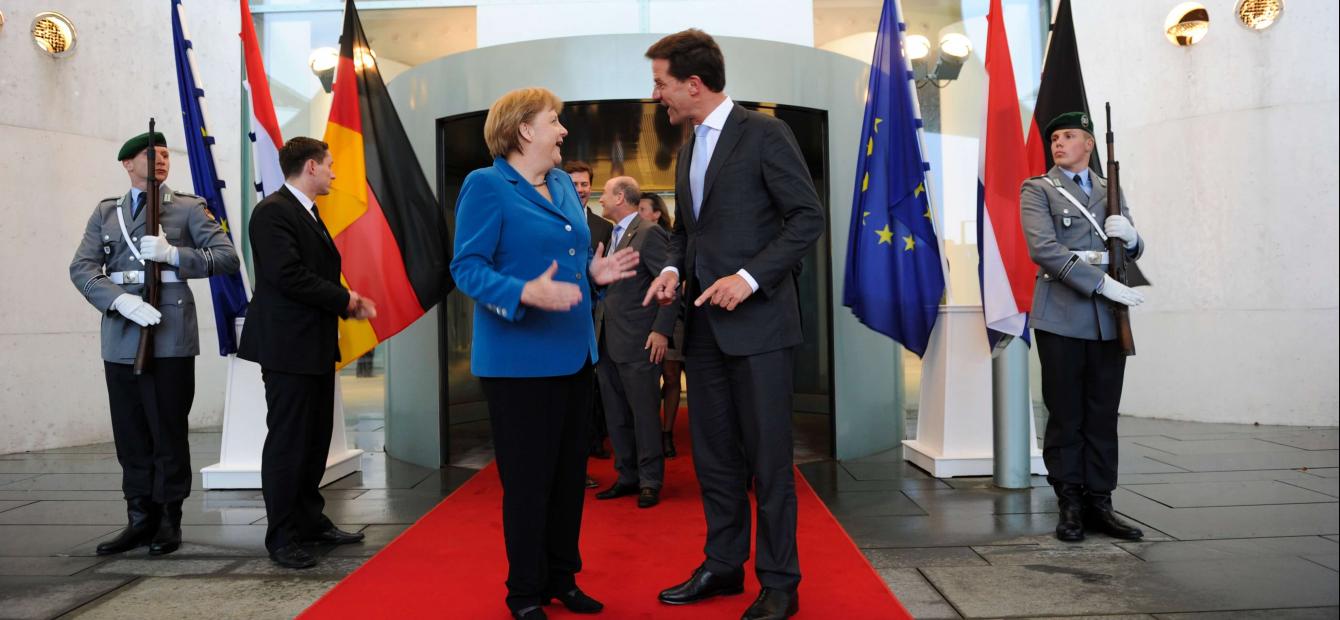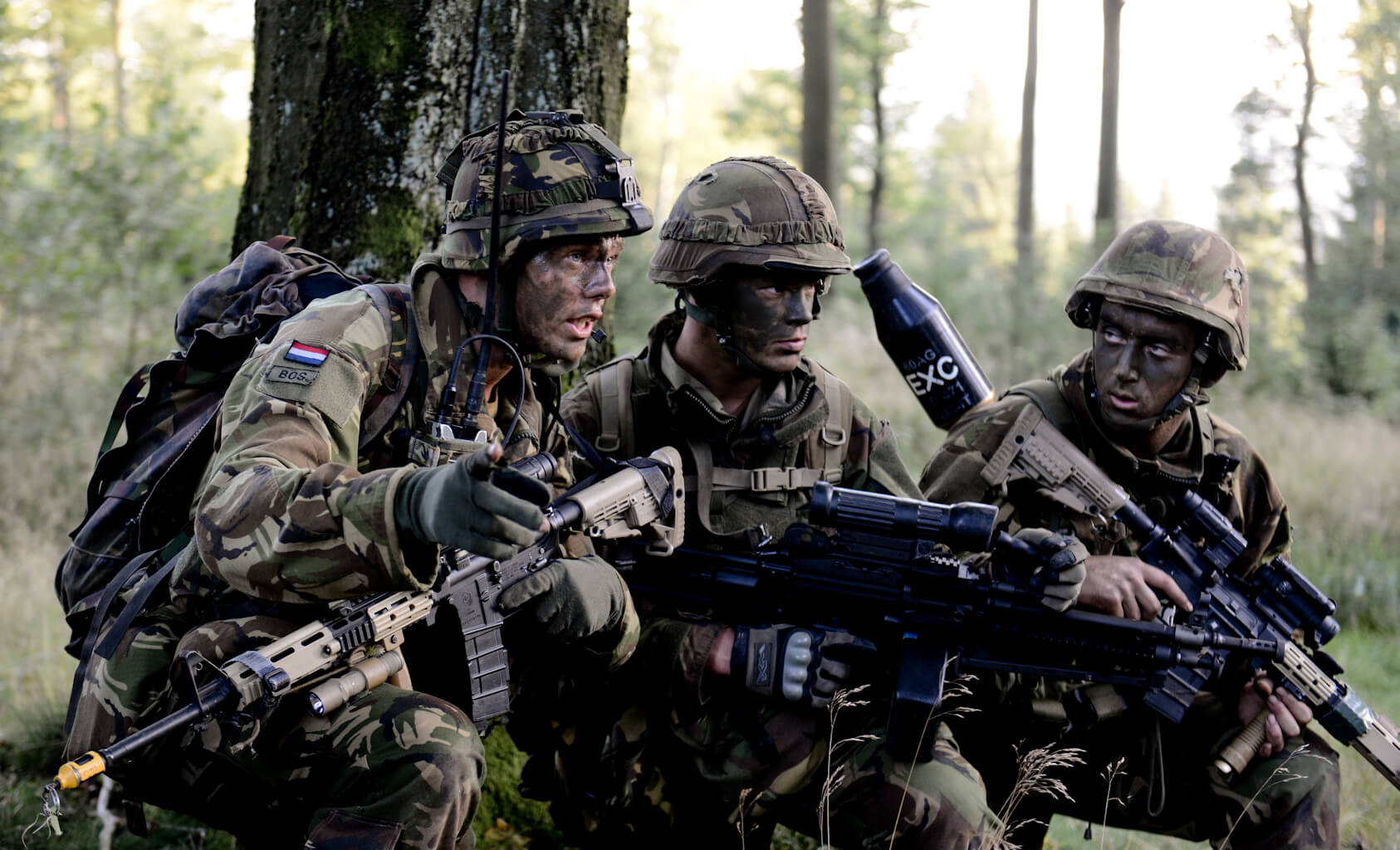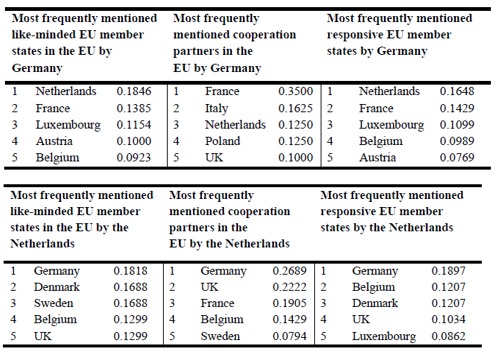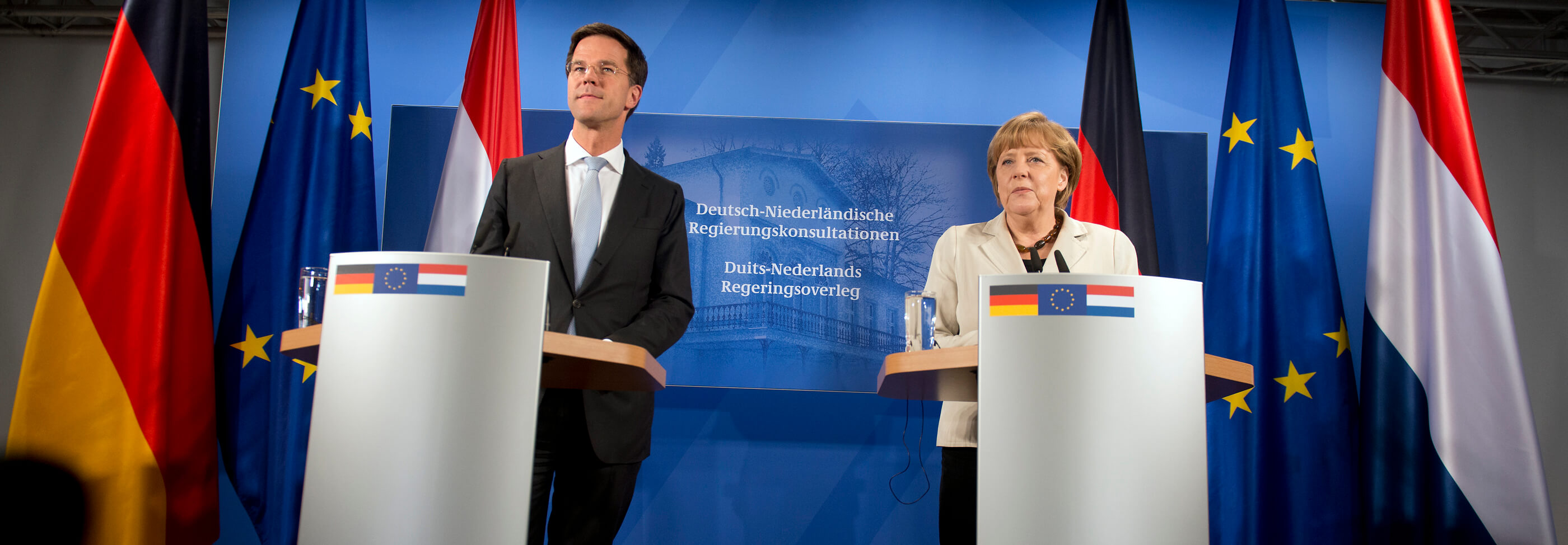
Multilateral effect of Dutch-German bilateralism in the EU
In the face of waning EU solidarity and growing EU scepticism differentiated integration in a ‘Europe of multiple speeds’ is to carry forward the project beyond the 60th anniversary of the Rome Treaty. However, it is feared that a multi-speed Europe breaks apart into first and second-class member states, and that existing dividing lines will be deepened.
Political scientists have identified, amongst others, dividing lines that limit ‘political space’ and undermine cohesion in the EU, a chasm between big and smaller members. Already a decade ago, Permanent Structured Cooperation (an avenue of flexible integration in the Lisbon Treaty) between heavyweights was predicted to pit the big against the smaller member states. The fact that at the Versailles-Summit (March 2017) four heavyweights – France, Germany, Italy and Spain – deliberated on the EU’s post-Brexit future and expressed their support for a different-speed Europe does little to alleviate this anxiety.
Member state alliances that (have the potential to) drive EU cooperation between the big and the smaller ones must thus be identified, preserved and strengthened. Typically, EU scholars praise axes between heavyweights, most notably the Franco-German one. It is due to their joint pro-European agenda for one thing and their network power for another that ‘Mercron’ is expected to be the engine of intensified EU cooperation. The possibility is overlooked that, on the same two conditions, an alliance between a big and a small member state could be an axis around which EU consensus- and coalition-building revolves. In fact, proximity between partners of different magnitude bears unique potential: to bridge already existing distances between big and smaller member states.
Dutch-German bilateralism has the potential to bridge a structural lack of engagement between big and smaller member states
A network analysis of the ECFR (European Council on Foreign Relations) dataset – the newest of its sort – provides insight into alignment patterns in the EU.1 The data were gathered through an anonymous online questionnaire conducted between June and September 2016, asking hundreds of policy-makers and expert observers in all 28 member states whom their governments perceive as particularly like-minded, whom it contacts often and finds especially responsive.
It reveals that Dutch-German bilateralism has the potential to bridge a structural lack of engagement between big and smaller member states, based on their unique bilateral proximity on the one hand and the network capital of Berlin and The Hague amongst members of their own size on the other. In the face of the awaited revival of the Franco-German axis, anonymous interviews with Dutch and German policy-makers in Brussels, Berlin and The Hague confirm and substantiate the distinct ‘multilateral effect’ of Dutch-German bilateralism in praxis.

Bilateral proximity: Joint pro-European agenda
Since the mid-1990s Dutch-German bilateralism incrementally deepened, and is now characterized by the catchphrase ‘proximity despite asymmetry’.Their partnership constitutes a regularized and durable infrastructure of political, military and cultural cooperation, as well as extensive trade relations. As for economics, Germany and the Netherlands are asymmetrically yet mutually dependent: Germany is the Netherlands’ most important trading partner (both in terms of import and export) and the trade relations with the Netherlands are amongst Germany’s most valuable.2
Political ties are maintained through a regular exchange of views between Foreign Ministry officials (as of 1995), parliamentary groups (as of 2003) and government-consultations (as of 2013) – a summit format including heads of state that Berlin only set up with two other, large EU member states.3 The political dialogue goes hand in hand with inter-societal exchange. The Dutch-German Conference (since 1996), for example, is a platform for politicians and civil society to discuss topics with societal relevance and serves to create common understanding.4 Cross-border cooperation in ‘Euregios’ deepens political, economic and cultural networks. What is more, the integration of their military forces constitutes the closest military bilateral cooperation within the European Union – a manifestation of mutual trust par excellence.5
The ECFR dataset finds that the bilateral proximity that appears from this complex of relations is balanced: the ties between the Netherlands and Germany are proportionally reciprocated. Both rate the other as the most like-minded and most responsive country within the EU, with approximately the same percentage. With all eyes on Germany from every corner of the EU, the affection felt by the Dutch is not exceptional. However, only a few of them see their favour returned – amongst them the Netherlands, with whom Germany cooperates more frequently than with bigger member states such as Poland, the UK or Spain.
Figure 1. Proximity of Germany and the Netherlands to other member states

The proximity of Germany and the Netherlands is reflected best in their Europapolitik: the joint endeavour to provide guidance on European integration is characteristic for Dutch-German bilateralism in the post-cold war era. During a state-visit to the Netherlands in 1995, and repetitively afterwards, the recently deceased former Bundeskanzler Helmut Kohl repetitively stated that “there is a great deal of common ground in both of our countries concerning the process of European Integration”.6
At the first government consultations in 2013, Bundeskanzlerin Merkel reasserted that the Netherlands and Germany pursue many of the same causes in the EU.
Network power amongst the Big Six and the Smaller Affluent Six
As important a precondition as the couple’s ‘leadership ambitions’ for an axis to deepen European cooperation is other members’ willingness to follow. The Hague and Berlin are part of two size-determined sub-networks that emerge from the ECFR dataset: the Big Six (Germany, the UK, France, Italy, Spain, Poland) and the Smaller Affluent Six (the Benelux countries and the Scandinavian member states). In comparison to the density and the clustering coefficient in the EU (0.0371 and 0.5960), the cohesion indicators in the former sub-group (0.0955 and 1.000) and the latter one (0.0870 and 0.7880) are substantially higher. The Big Six and the Smaller Affluent Six regularly act as blocs in EU negotiations, pooling their strengths for a common cause. It is thus the centrality (i.e. power) of the Netherlands and Germany in their respective networks that determines the multilateral reach of their bilateral proximity and constitutes the ‘group mandates’ for their joint European leadership.
In the Big Six, Germany turns out to be most central. It scores highest on ‘in-degree centrality’: the sum of the values of the ties directed at it by the network members. Moreover, Germany is the actor coalition members are closest to in terms of path distance. It is in close proximity to all others and the only node with which all connect themselves directly – explaining why it is most central measured by ‘in-closeness centrality’.
Because of its central position in the Big Six network, Berlin acts as an intermediary between peripheral actors in the group, between whom there are no direct strong ties – for example between Poland and Spain. Five out of 15 edges in the sub-group classify as weak, i.e. below the threshold. Germany bridges all of these ‘structural gaps’, forging secondary connections between otherwise detached network members. France, with the second most network power, bridges only two of them. With Berlin gone, the cohesion of the Big Six network would drop dramatically.
The Netherlands too is the most central node in its sub-network, the Smaller Affluent Six. It is highest on in-degree and in-closeness centrality. The connections to the Netherlands are valued most and the paths are shortest. As a result of its prominent position, The Hague brokers between peripheral actors without a direct connection – for example Finland and Belgium. Six out of 15 ties fall below the threshold. The Hague bridges all structural gaps between distant network members, whilst none of the other nodes do. Would the Netherlands not be in their midst, the group would not be as cohesive as displayed.
Figure 2. Strong ties amongst the Big Six and the Smaller Affluent Six

The multilateral effect of Dutch-German bilateralism in the EU
The ECFR dataset confirms there indeed is a lack of strong structural ties between the Big Six and the Smaller Affluent Six: out of 36 possible inter-group ties, no less than 23 are missing. This is not to say that big and smaller affluent members do not pragmatically team up in practise, but that there is an enduring need for mediation to forge secondary, ad hoc connections between them. The Dutch-German duo – drawing upon their exceptional bilateral proximity on the one hand and their network capital in their respective subgroups on the other – has unique potential in this regard. Indeed, the Dutch-German duo scores high on ‘edge-betweenness’, structurally linking disconnected pairs of big and smaller affluent members.
The Netherlands’ benign image as a smaller member state is of tactical use to Germany as a gentle giant
Dutch and German officials (handling EU-affairs in Berlin, The Hague and Brussels) as well as expert-observers confirm the multilateral effect of Dutch-German bilateralism in practice. Interviewees point out how Dutch-German bilateralism sought and succeeded to leave its mark on affairs that were at the top of the Council’s agenda in recent years. In the handling of the Greek government-debt crisis (2010) it was this duo that successfully advocating the involvement of the IMF, counterbalancing the Commission.
The EU-Turkey deal (March 2016) was a Dutch-German initiative concluded to mend the migration crisis. It constitutes an example par-excellence of their joint leadership. “There was close, informal contact between the Sherpa’s as well as between the Dutch climate ambassador and the Bundeskanzleramt (...). Telephone calls, text messages. Multiple times a week.” The manner in which Bundeskanzlerin Merkel and Prime Minister Rutte took the lead in the European Council, was “what you would expect from the Franco-German cooperation.” Many member states and the presidents of the Commission and the Council were overrun (disturbed even) by so much thoroughness.
Two key observations appear from the interview series. First, the nature of the Dutch-German relationship determines its multilateral effect and sets it apart from the Franco-German axis. Whereas Paris-Berlin forges a European compromise if they manage to bridge the considerable distance between them, Berlin-The Hague rallies like-minded coalitions, getting member states who are principally of the same mind to act. In other words: the Franco-German axis contributes to consensus-building, Dutch-German bilateralism to coalition-building.

Secondly, in doing so, asymmetry in size account for their success. The network power of Berlin and The Hague amongst members of their own size is instrumental in “enlarging a Dutch-German alliance that often forms the coalition core”. In practice, initiatives taken by or together with a smaller member state are easier to digest and, with a large member state throwing its weight behind them, have a chance of succeeding. Oftentimes, there is a(n) (agreed) division of labour: the Netherlands adopts clear positions as a vocal flank player, which frees Germany – a heavyweight with a historical burden to find compromise – to seek to find the middle ground. The Netherlands’ benign image as a smaller member state is of tactical use to Germany as a gentle giant. In the face of general uneasiness about Germany taking the lead and Berlin’s own anxiety to be perceived as imposing its will, Germany’s exceptional relationship with this smaller member state does justice to the European idea of cooperating on an equal footing.
Will the Dutch-German engine stall?
Bilateral relationships between other Big Six and Affluent Small members cannot make up for the added value of the German-Dutch bilateral relationship’s multiplier effect. The close bilateral relationships across these groups that do exist (e.g. between France and Belgium) are not as crucial for EU coalition building as The Hague-Berlin because either one of the parties lack a ‘group mandate’ in the form of network power.
Contemporary events in the European Union shed light on the vulnerability of the Dutch-German engine. In the short term, the relative importance of the Netherlands for Germany might diminish as the Franco-German motor stops malfunctioning under the newly elected French President Macron. Dutch interviewees maintain that close high-level Dutch-German cooperation in recent years can be partially explained by the strained relationship between Berlin and Paris under President Hollande. In the past, Berlin has demonstrated to side with Paris if the French insist and preserve this ‘marriage of convenience’ – also if that means cheating on loved ones.
In the medium term, The Hague might be forced to play ‘hard to get’ and – if only for the record – publicly call into question its proximity to Berlin. With Brexit The Hague will lose an important large, alternative partner to Germany, which would limit its options and thus its strategic relevance.
Besides, ever growing EU-scepticism both in the Netherlands and in Germany might drive a wedge between The Hague and Berlin. After all, their proximity roots in their common Europapolitik. Whilst they are stuck in the opposition, the EU-sceptical Partij voor de Vrijheid (13%, a win of 2.9%) and Alternative for Germany (12.6%, a win of 7.9%) both won in the recent elections. Much will depend – for the Dutch-German bilateral relationship, and thus for Europe as a whole – on how these parties perform in the next elections.
- 1The EU Coalition Explorer (2017), European Council on Foreign Relations. Previous coalition research analyzed data from: the DEU (Decision-making in the EU, 1999), EMP (EuroManifestos, Positions and Salience in European Union Politics, 2004), EUPOL (European Union Policy-Making, 2011) and DEU II (2012).
- 2Deutsch-Niederländische Handelskammer, 2017. In 2016, the total volume of the trade between Germany and the Netherlands was 162.69 billion Euros. Germany’s trade volume is only higher with China, France and the USA. In 2016, the Netherlands ranked second on Germany’s import and fourth on its export record. See: In 2015, German direct investments within the EU were highest in the Netherlands (14,94 billion). From all its EU investments the Netherlands has been investing second most in Germany (5,822 billion). See: Bundesbank
- 3I.e. with France and Poland.
- 4Examples of cultural and educational fora are: Nederlandse Stuurgroep, youth-exchange programme, journalism scholarship, Dutch-German Conference, TaalUnie, Duitsland Instituut Amsterdam, Zentrum für Niederlande-Studien (Münster), Bundesarbeitsgemeinschaft für deutsch-niederländische Kulturarbeit.
- 5The Dutch-German corps in Münster, founded in 1995, served as headquarters for the NATO Response Force in 2002 and led the ISAF mission in Afghanistan between 2003 and 2009. After the integration of a Dutch air brigade in the Division Schnelle Kräfte in 2014, the ministers of Defence signed an agreement in 2016 to integrate the German Sea Battalion in the Dutch Marine by 2018.
- 6I. Schiweck, Zur Haltung der niederländischen Parlamentarier zum wiedervereinigten Deutschland in einem sich einigenden Europa. Eine analytische Bestandsaufnahme der deutsch-niederländischen Beziehungen unter besonderer Berücksichtigung der europapolitischen Partnerschaft (Frankfurt am Main: Peter Lang, 1999, p. 49.




0 Comments
Add new comment